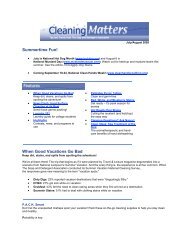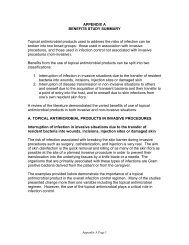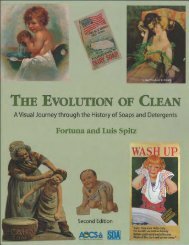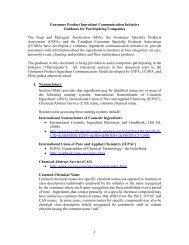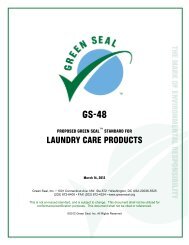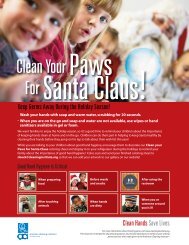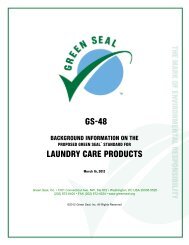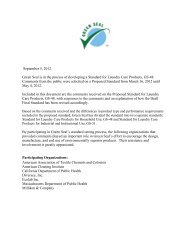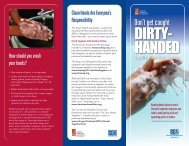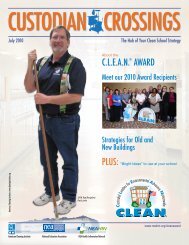subchapter c -- federal hazardous substances act regulations
subchapter c -- federal hazardous substances act regulations
subchapter c -- federal hazardous substances act regulations
Create successful ePaper yourself
Turn your PDF publications into a flip-book with our unique Google optimized e-Paper software.
Correction = (X + Y) / 2.<br />
Where:<br />
A=Observed flash of p- xylene, and<br />
B=Observed flash of isopropyl alcohol.<br />
Apply this correction of all determinations.<br />
Half units in correction shall be discarded.<br />
PRECISION<br />
9. (a) For hydrocarbon solvents having<br />
flashpoints between 60 °F. and 110 °F.,<br />
repeatability is ±2 °F. and the reproducibility<br />
is ±5 °F.<br />
(b) If results from two tests differ by more<br />
than 10 °F., they shall be considered uncertain<br />
and should be checked. This calibration<br />
procedure provided in this method will cancel<br />
out the effect of barometric pressure if<br />
calibration and tests are run at the same<br />
pressure. Data supporting the precision are<br />
given appendix III of the 1956 Report of<br />
Committee D–1 on Paint, Varnish, Lacquers<br />
and Related Products, Proceedings, Am. Soc.<br />
Testing Mats., Vol. 56 (1956).<br />
NOTE: The test apparatus and procedure<br />
described in § 1500.43 may be used by<br />
manuf<strong>act</strong>urers and labelers of products subject<br />
to the Federal Hazardous Substances Act to<br />
determine flashpoint temperatures of those<br />
products under the conditions set forth in §<br />
1500.3(c)(6)(iv), as amended.<br />
§ 1500.43a Method of test for flashpoint of<br />
volatile flammable materials.<br />
(a) Scope. (1) This method describes the<br />
test procedure which the Commission will use<br />
for the determination of the flashpoint of<br />
volatile flammable materials, using a Setaflash<br />
2<br />
low-range closed tester, or an apparatus<br />
producing equivalent results. The method<br />
described in this section is essentially a<br />
Setaflash equilibrium procedure which closely<br />
parallels the test method designated ASTM D<br />
3828-81, “Standard Test Methods for Flash<br />
Point by Setaflash Closed Tester,” published<br />
by the American Society for Testing and<br />
Materials (ASTM), 1916 Race Street,<br />
2 Setaflash is a registered trademark of Stanhope-<br />
Seta Limited, Surrey, England.<br />
16 CFR Ch. II (1–1–05 Edition)—proposed modificication – 6/25/06<br />
-- 41 --<br />
Philadelphia, Pennsylvania 19103.<br />
Manuf<strong>act</strong>urers and labelers of products subject<br />
to labeling and other requirements under the<br />
Federal Hazardous Substances Act may use<br />
other apparatus and/or test methods which<br />
produce equivalent results.<br />
(2) At the option of the user, the<br />
procedures described in this section may be<br />
used to determine the <strong>act</strong>ual flashpoint<br />
temperature of a sample or to determine<br />
whether a product will or will not flash at a<br />
specified temperature (flash/no flash).<br />
(3) If the substance to be tested has a<br />
viscosity greater than 150 Stokes at 77 °F (25<br />
°C), see paragraph (n) of this section for<br />
modifications to the testing procedure.<br />
(4) If the Commission has reason to<br />
believe on the basis of reliable experience or<br />
other relevant information or data that the<br />
flammability hazard of a substance is greater<br />
or less than its flammability classification<br />
based on flashpoint temperature determined in<br />
accordance with this § 1500.43a and that the<br />
substance should be reclassified, the<br />
Commission will initiate a rulemaking<br />
proceeding for reclassification of the<br />
substance. Product manuf<strong>act</strong>urers and labelers<br />
may use reliable experience or other relevant<br />
information or data in addition to the<br />
flashpoint temperature of a substance as a<br />
basis for compliance with any applicable<br />
requirements of the Federal Hazardous<br />
Substances Act in the absence of a rule issued<br />
by the Commission to reclassify the substance.<br />
(b) Summary of test methods. (1) Method<br />
A — Flash/No Flash Test. A specified volume<br />
of sample is introduced by a syringe into the<br />
cup of the apparatus that is set and maintained<br />
at the specified temperature. After a specific<br />
time a test flame is applied and an observation<br />
made as to whether or not a flash occurred.<br />
Test procedures are set forth in detail in §<br />
1500.43a(i).<br />
(2) Method B — Finite (or Actual)<br />
Flashpoint. (i) A specified voume of sample is<br />
introduced into the cup of the apparatus that is<br />
maintained at the expected flashpoint. After a<br />
specified time a test flame is applied and the<br />
observation made whether or not a flash<br />
occurred.<br />
(ii) The specimen is removed from the cup,<br />
the cup cleaned, and the cup temperature<br />
adjusted 5 °C (9 °F), lower or higher<br />
depending on whether or not a flash occurred



